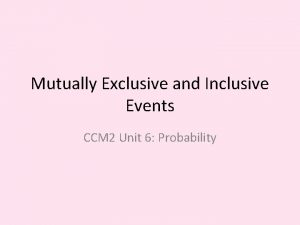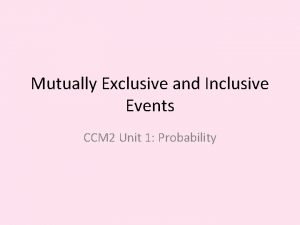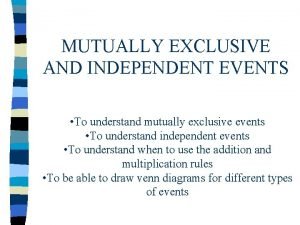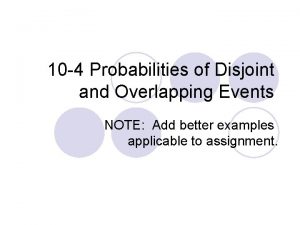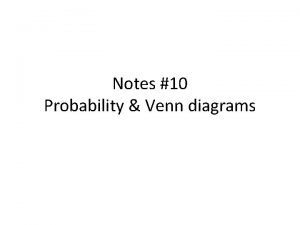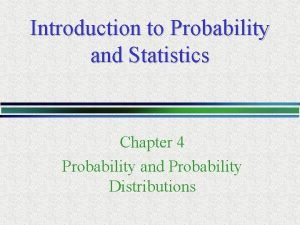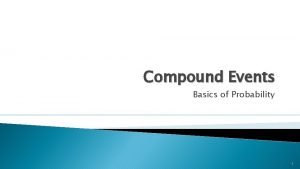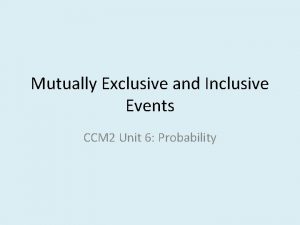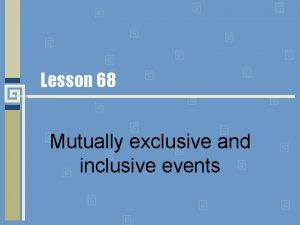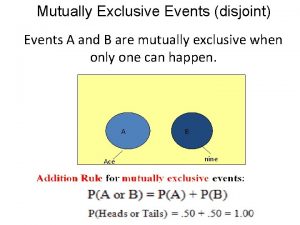Mutually Exclusive and Inclusive Events CCM 2 Unit









- Slides: 9

Mutually Exclusive and Inclusive Events CCM 2 Unit 6: Probability

Mutually Exclusive Events • Suppose you are rolling a six-sided die. What is the probability that you roll an odd number or you roll a 2? • Can these both occur at the same time? Why or why not? • Mutually Exclusive Events (or Disjoint Events): Two or more events that cannot occur at the same time. • The probability of two mutually exclusive events occurring at the same time , P(A and B), is 0! • Video on Mutually Exclusive Events

Probability of Mutually Exclusive Events • To find the probability of one of two mutually exclusive events occurring, use the following formula: P(A or B) = P(A) + P(B) • Here’s an easy way to remember: – AND in a probability problem with two events means to MULTIPLY (this is what we learned last class!) – OR in a probability problem with two events means to ADD

Example 1 If you randomly chose one of the integers 1 – 10, what is the probability of choosing either an odd number or an even number? • Are these mutually exclusive events? Why or why not? – Yes, they cannot happen at the same time! • Complete the following statement: P(odd or even) = P(_____) + P(_____) P(odd or even) = P(odd) + P(even) • Now fill in with numbers: P(odd or even) = _______ + ____ P(odd or even) = ½ + ½ = 1 Does this answer make sense? Yes, all integers 1 -10 are either odd or even!

Mutually Inclusive Events • Suppose you are rolling a six-sided die. What is the probability that you roll an odd number or a number less than 4? • Can these both occur at the same time? If so, when? • Mutually Inclusive Events: Two events that can occur at the same time. • Video on Mutually Inclusive Events

Probability of the Union of Two Events: The Addition Rule • We just saw that the formula for finding the probability of two mutually inclusive events can also be used for mutually exclusive events, so let’s think of it as the formula for finding the probability of the union of two events or the Addition Rule: P(A or B) = P(A) + P(B) – P(A and B) ***Use this for both Mutually Exclusive and Inclusive events***

2. What is the probability of choosing a number from 1 to 10 that is less than 5 or odd? (Draw a Venn Diagram of the situation first) <5 2 4 Odd 1 3 5 7 9 6 8 10 P(<5 or odd) = P(<5) + P(odd) – P(<5 and odd) Less than 5 and Odd <5 = {1, 2, 3, 4} odd = {1, 3, 5, 7, 9} = 4/10 + 5/10 – 2/10 = 7/10 The probability of choosing a number less than 5 or an odd number is 7/10 or 70%.

3. A bag contains 26 tiles with a letter on each, one tile for each letter of the alphabet. What is the probability of reaching into the bag and randomly choosing a tile with one of the first 10 letters of the alphabet on it or randomly choosing a tile with a vowel on it? Before you try the formula, see if you can figure it out logically! Now, let’s check with the formula P(one of the first 10 letters or vowel) = P(one of the first 10 letters) + P(vowel) – P(first 10 and vowel) = 10/26 + 5/26 – 3/26 = 12/26 or 6/13 The probability of choosing either one of the first 10 letters or a vowel is 6/13 or 46. 2%

4. A bag contains 26 tiles with a letter on each, one tile for each letter of the alphabet. What is the probability of reaching into the bag and randomly choosing a tile with one of the last 5 letters of the alphabet on it or randomly choosing a tile with a vowel on it? Before you try the formula, see if you can figure it out logically! Now, let’s check with the formula P(one of the last 5 letters or vowel) = P(one of the last 5 letters) + P(vowel) – P(last 5 and vowel) = 5/26 + 5/26 – 0 = 10/26 or 5/13 The probability of choosing either one of the first 10 letters or a vowel is 5/13 or 38. 5%


